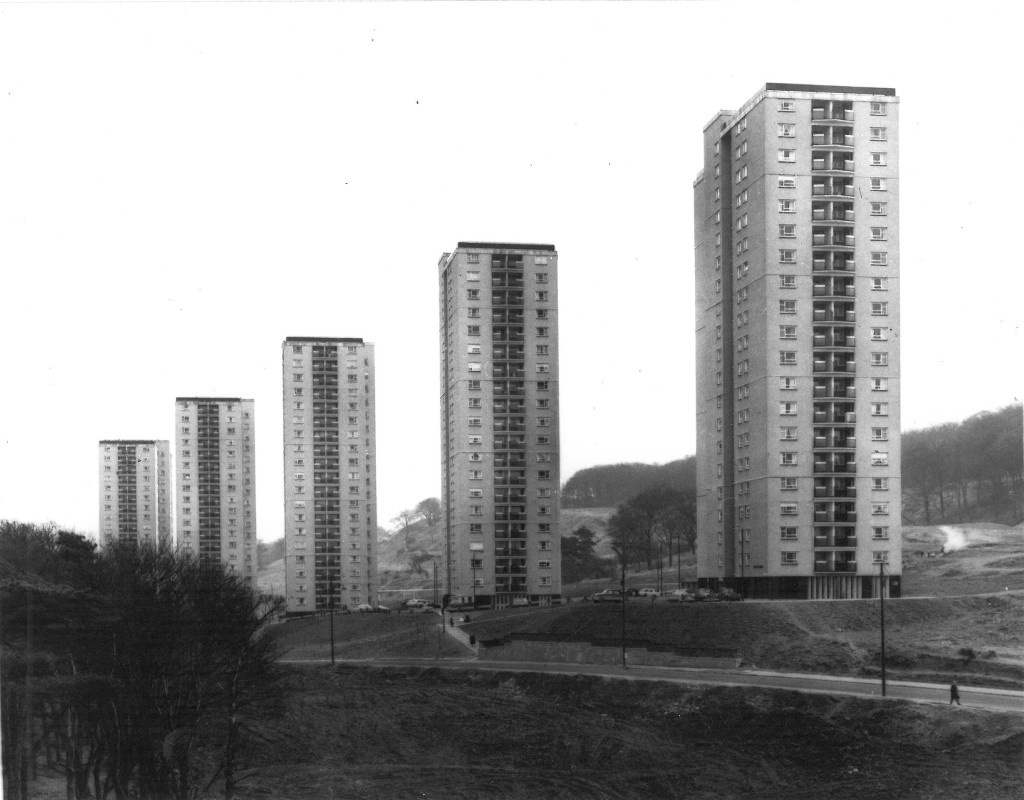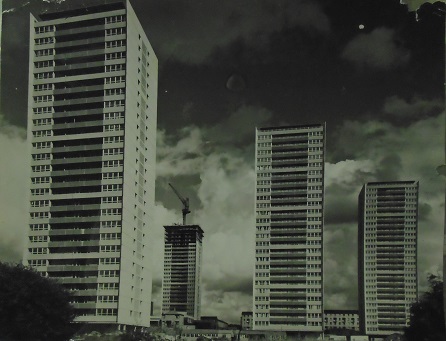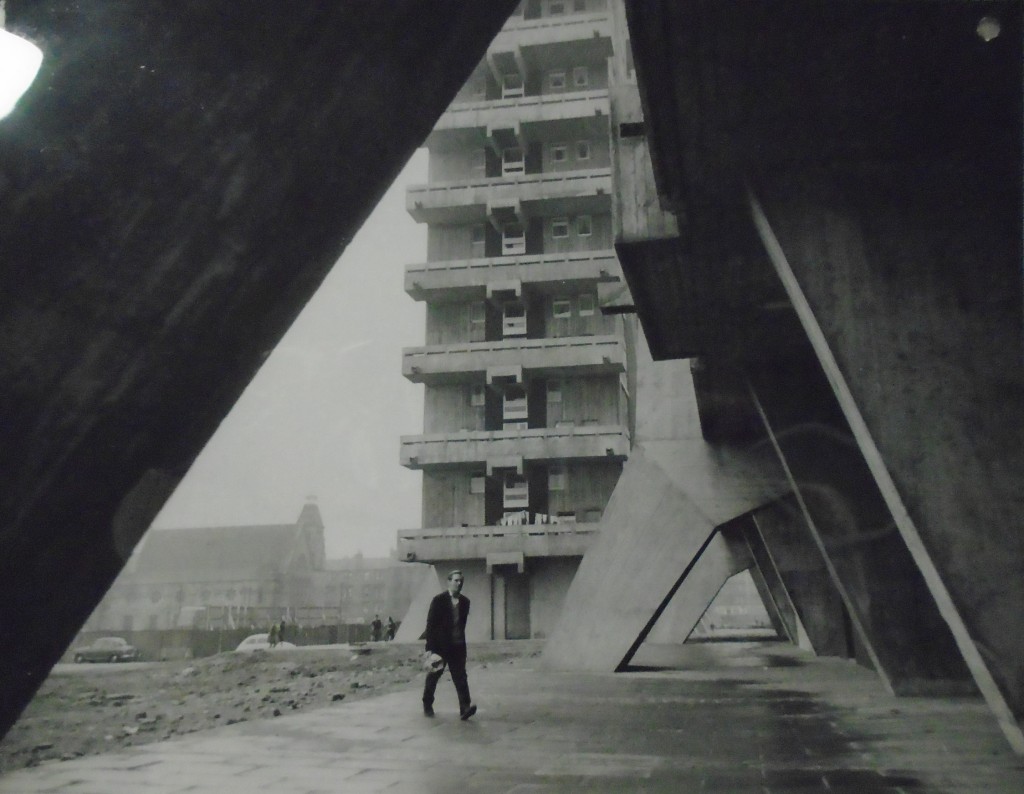Glasgow 1950-1975
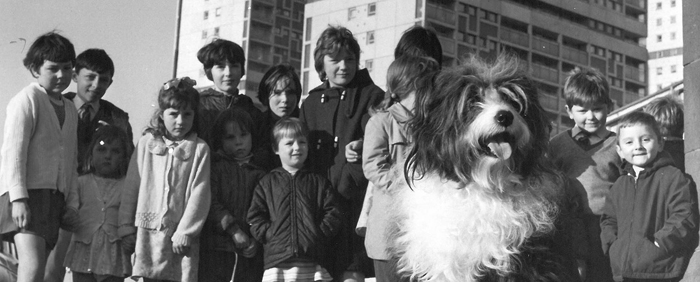
In the post war decades, Glasgow was notorious as the most ‘slum-ridden’ city of Britain. To tackle its urban squalor, massive schemes of slum clearance, public housing and urban redesign were undertaken on an unparalleled scale. Hundreds of thousands of the city’s people were rehoused. This project has provided a much-needed long-term assessment of this mass relocation focusing on two case studies: the new town and the high-rise estate, against a background of 50 years of significant economic and social change characterised by the decline of heavy industry and subsequent urban regeneration and cultural renaissance.
Further information
Housing, everyday life and wellbeing over the long term in Glasgow c.1950–1975 is a Leverhulme funded project which has employed a historical approach to explore the long-term impact of re-development and forced relocation in post-war Glasgow.
After the Second World War, modern homes in high rises and new towns were identified as the solution to inner city overcrowding, an approach championed on behalf of the working classes by architects, planners, and local officials. Glasgow was nationally influential in its approach, which channelled this modernist impulse into homes, designed and built with a modern aesthetic and with the use of new building materials and techniques. More than fifty years on from the inception of Glasgow's housing revolution there are lessons to be learned from this massive public housing experiment.

Source: ©Nick Hedges (as featured in 'Gorbals' by Ruth Hedges)

Source: Post-war housing no.2, A/30/F/6, Glasgow City Council, Libraries Information and Learning.
Research on the success or failure of social housing and relocation has generally tended to focus on short-term impacts. Very soon after the slum clearance and rebuilding programmes of the 1950s and 1960s, the criticism was made, and has stuck thereafter, that the main impact of such developments was to cause the ‘destruction of communities’ and ‘social displacement'. Despite a lack of research on the ongoing effects since, this has proved a very influential narrative, so much so that present-day urban restructuring has been said to have parallels with the earlier epoch, with policy-makers and planners having failed to learn the lessons from the past.
This project has employed a historical approach in revisiting this period of post-war redevelopment and has asked to what degree it succeeded or failed, for whom, and in what context, over the longer term. Ultimately, understanding what has happened to people in social housing across the lifecycle, and over several decades, has provided important lessons for the conduct and prospective impacts of restructuring programmes today.
Key findings
We have obviously learned a great deal about the process of relocation, settling in to new housing in high rise estates in Glasgow or in East Kilbride, and the outcomes for individuals over the long term. The oral history life narrative interviews conducted for the project (see section below) were crucial to our understanding of these processes.
Among our key findings from the project are:
- There are clear benefits to accessing subjective memories of relocation and placing these in the context of longer term housing pathways across the life course.
- The overwhelming satisfaction expressed by tenants of high rise flats in the 1960s must be judged in the context of former housing conditions – the new homes were a qualitative improvement on what had gone before and were perceived as a new start – and residents’ present circumstances.
- Contrary to the findings of some influential studies, relocation was not always a negative experience in respect of family and kin relationships.
- In the case of the new town, new social identities were formed, distinct from those shaped in the city.
- In terms of design, despite the greater tendency of urban Scots to live in flats, the majority of tenants desired a house with their own front door (signifying autonomy and social mobility) and this aspiration grew as time passed.
- As the composition of residents on social housing estates altered, concerns from original tenants about the changed social mix and social breakdown destabilised communities which had originally appeared socially coherent.
Project Outputs
Monograph
Abrams, L. , Kearns, A. , Hazley, B. and Wright, V. (2020) Glasgow: High-Rise Homes, Estates and Communities in the Post-War Period. Series: Built environment city studies. Routledge: London. ISBN 9781138317093 (doi:10.4324/9780429455339)
Journal Articles
Hazley, B., Abrams, L. , Kearns, A. and Wright, V. (2021) Place, memory and the British high rise experience: negotiating social change on the Wyndford Estate, 1962–2015. Contemporary British History, 35(1), pp. 72-99. (doi: 10.1080/13619462.2020.1845148)
Abrams, L. , Fleming, L., Hazley, B., Wright, V. and Kearns, A. (2019) Isolated and dependent: women and children in high-rise social housing in post-war Glasgow. Women's History Review, 28(5), pp. 794-813. (doi: 10.1080/09612025.2018.1472897)
Hazley, B., Wright, V., Abrams, L. and Kearns, A. (2018) 'People and their homes rather than housing in the usual sense’? Locating the tenant’s voice in Homes in High Flats. Women's History Review,(doi:10.1080/09612025.2018.1472890) (Early Online Publication)
Kearns, A. , Wright, V. , Abrams, L. and Hazley, B. (2019) Slum clearance and relocation: a reassessment of social outcomes combining short- term and long-term perspectives. Housing Studies, 34(2), pp. 201-225. (doi: 10.1080/02673037.2017.1409342)
Wright, V. , Kearns, A. , Abrams, L. and Hazley, B. (2019) Planning for play: seventy years of ineffective public policy? The example of Glasgow, Scotland. Planning Perspectives, 34(2), pp. 243-263. (doi: 10.1080/02665433.2017.1393627)
Abrams, L. , Hazley, B., Wright, V. and Kearns, A. (2018) Aspiration, agency, and the production of new selves in a Scottish new town, c.1947–c.2016. Twentieth Century British History, 29(4), pp. 576-604. (doi: 10.1093/tcbh/hwy006) (PMID:29860425)
'Multi-storey Memories' - Oral Histories
One of the aims of this project was to find out what life was really like for those who lived in high rise flats in Glasgow in the post war years and especially the 1960s and 1970s.
Many people have written about why the flats were built or their architectural merits but very few have told the story of the people who lived in them.
We wanted to ensure that residents of high rise could tell their own story in their own words.
As well as conducting oral history life narrative interviews with residents and formal residents we also created an online questionnaire, with some of the results being published on this website with the permission of those contributing. We have also created an online resource where you can listen to what people had to say about living in high rise in the four case study areas covered by the project.
To find out more click on the relevant links on the left or click here:
Housing and Wellbeing in Glasgow blog
Case Studies
Homes in High Flats Case Studies
By the late 1960s there were growing concerns about the potential negative effects that living in high rise flats might have on individual and particularly young families. Pearl Jephcott, a sociologist embarked on the largest contemporary study of high rise between 1967 and 1969 in Glasgow. A 5 per cent sample of families living in high flats were interviewed by market researchers and 1,066 questionnaires were completed. At this point there were 163 high rise blocks in Glasgow as illustrated in the map below. Her aim was to hear what residents had to say about life in high rise and her published study Homes In High Flats often featured direct quotations from residents.
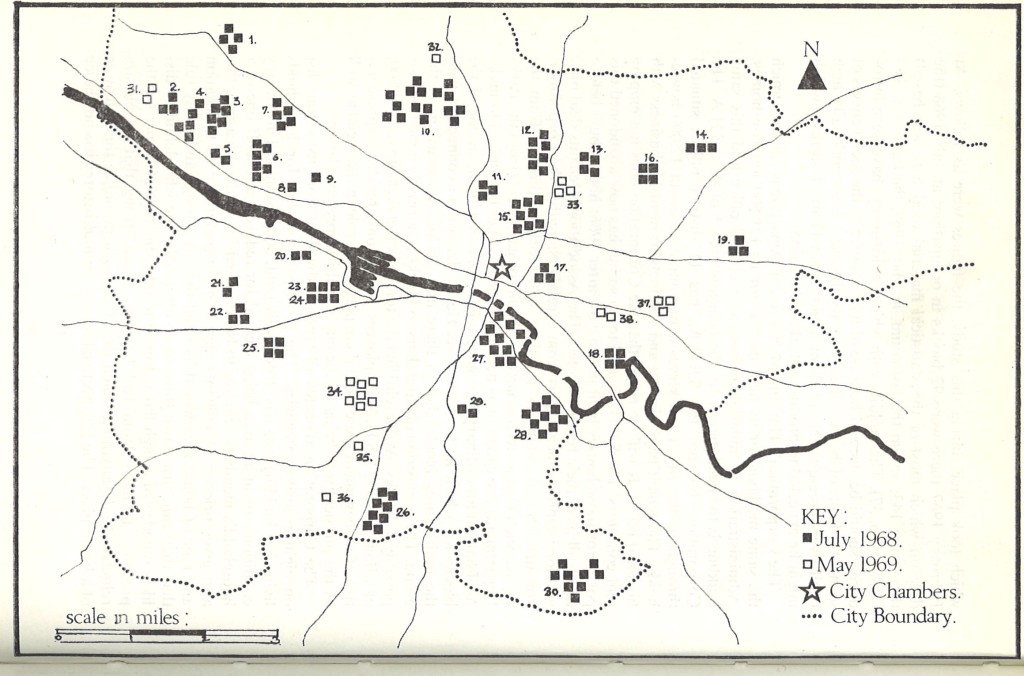
Source: P. Jephcott and H. Robinson, Homes in High Flats, (Oliver & Boyd: Edinburgh), 1971, p. 20.
Alongside the questionnaire Jephcott chose to 'concentrate on a limited number of estates' as this would 'enable staff to make sustained relationships with individual households'. The five areas chosen, Castlemilk, Wyndford, Albion, Red Road and Royston, were thought to be 'not too 'untypical' of the estates as a whole'.
More about Jephcott's Case Studies
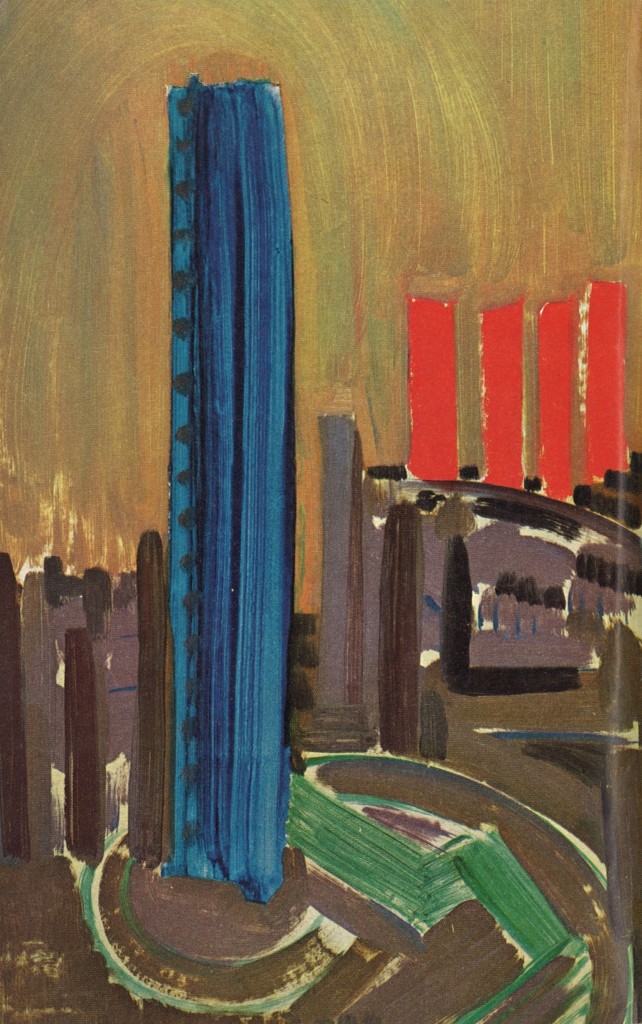
Source: P. Jephcott and H. Robinson, Homes in High Flats, (Oliver & Boyd: Edinburgh), 1971, front cover. Image © Miss D. Foy credited in the book as the artist
Pearl Jephcott's Homes in High Flats drew upon 1,066 questionnaires completed by residents throughout Glasgow. Alongside this questionnaire Jephcott also chose to 'concentrate on a limited number of estates' as this would 'enable staff to make sustained relationships with individual households'. The five areas chosen, Castlemilk, Wyndford, Albion, Red Road and Royston, were thought to be 'not too 'untypical' of the estates as a whole'.
Mitchellhilll in Castlemilk, which comprised of five 19 storey multi-storey blocks was chosen as a result of its position on the edge of a large postwar council estate. Jephcott notes that 'The semi-rural setting was judged very favourable for the child living in a high flat (once he was old enough to go out by himself) and Castlemilk was selected for special study largely for this reason' (p. 28).
Wyndford was chosen as it was close to a busy shopping street (Maryhill Road). This estate, which consisted of 16 multistorey blocks over 8 storeys and also low-rise flats, was (and is) situated on the site of an old barracks and was surrounded by 'a high and handsome wall' which meant that it was 'visibly self contained'. Jephcott states that 'socially it is believed to be settling down rather well' and this along with the fact it was built and managed by the Scottish Special Housing Association (SSHA) were the main reasons for its selection for in-depth study (p. 28).
Albion, an estate which no longer exists, consisted of three 19 multi-storey blocks, it was near the docks and 'hemmed-in' by an arterial road, Ibrox football stadium and a greyhound track.
Red Road, which has become an iconic representation of high rise living in Glasgow, was chosen by Jephcott because although it was only two miles north-east of the city centre 'it was curiously cut off from the main stream of city life'. At the point of her study only two of the eight 'massive blocks' (around 31 storeys high) had been occupied but both 'were already showing signs of social problems since the lifts were proving most inadequate'. There was also 'a high proportion of child-users'. The high proportion of children in these blocks were of interest to Jephcott (p. 30).
Finally, Royston was selected as one of Glasgow's 'earliest ventures in high flats'. The three 20 storey blocks had been completed in 1961 and Jephcott thought 'the novelty of this new type of home should have long worn off' which 'might make it a useful contrast to the city's high flats in general' (p. 30).
Multi-storey Memories Case Studies
We also decided to focus on particular areas as case studies. We selected four areas for our project: Castlemilk, Wyndford, Hutchesontown and Moss Heights.
Click on the images below to find out more:

This work is licensed under a Creative Commons Attribution-NonCommercial-ShareAlike 4.0 International License.
Some material on this website is not being made available under the terms of this licence.
These are:
Third-Party materials that is being used under fair use or with permission (photography owned by archives, blog contributors or from WikiMedia Commons). The respective copyright/Creative Commons licence details for use of third-party material should be consulted.



